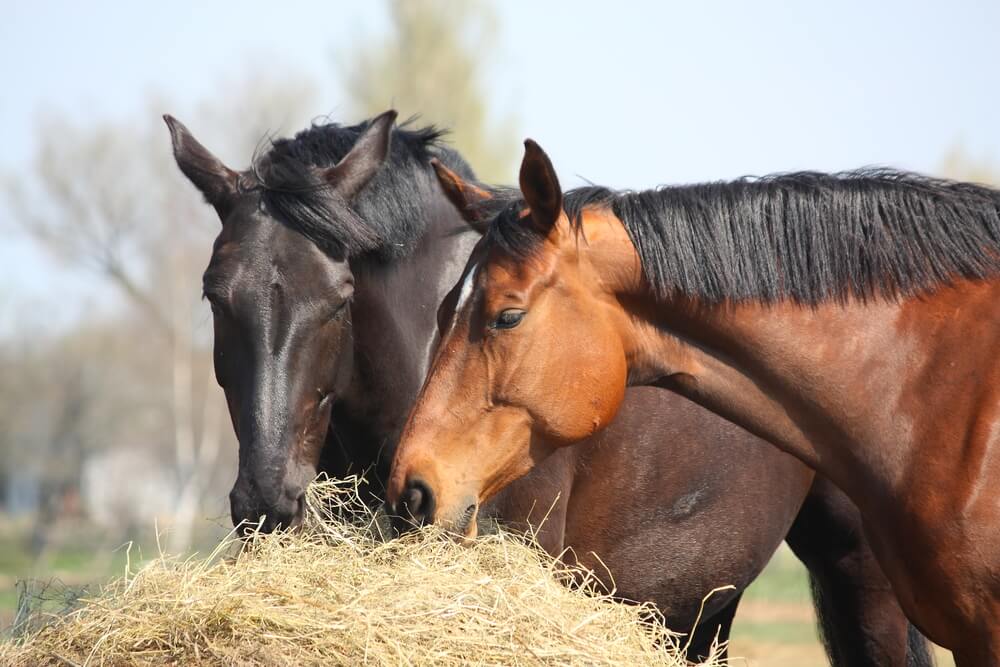At Stockley Outdoor & Equestrian, we believe that feeding in harmony with the horse’s digestive system is one of the most important choices a horse owner can make. Yet starch—often overlooked—is at the heart of many health and behavioural issues.
This article explores how horses digest starch, why excess is harmful, and how feeding naturally—with high-fibre, low-starch feeds—can transform your horse’s well-being.
The Horse’s Digestive System: Built for Fibre, Not Grain
Horses are herbivores with a digestive system designed for continuous intake of fibrous forage. Unlike ruminants like cows, which chew the cud and digest in multiple stomach chambers, horses have a simple stomach, followed by a complex hindgut fermentation system.
The stomach is relatively small, holding only 2–3 gallons, and food can pass through it quickly—often within 15–30 minutes. After that, digestion continues in the small intestine and then in the caecum and colon (the hindgut), where fibre is fermented slowly by beneficial microorganisms.
This system thrives on a consistent supply of hay or pasture—not on large, starch-rich meals.
Starch Digestion: What Happens and Where
Starch is a complex carbohydrate, commonly found in cereal grains like oats, corn, and barley. While small amounts can be tolerated, it’s crucial that starch is digested in the small intestine, not the hindgut.
The Enzymatic Breakdown of Starch
Starch digestion begins when a horse chews its feed, triggering enzyme production:
- Amylase: Secreted mainly by the pancreas, amylase begins breaking starch into smaller carbohydrate chains (like dextrins and maltose).
- Maltase & Isomaltase: Located on the brush border of the small intestine, these enzymes complete the job—splitting maltose into simple sugars like glucose.
Once glucose is formed, it’s absorbed through the intestinal lining into the bloodstream, where it fuels metabolic processes and energy production.
The Problem: What Happens When Starch Is Overfed
When a horse consumes more starch than it can digest in the small intestine, the undigested starch passes into the hindgut. There, it is rapidly fermented by bacteria—producing lactic acid and disrupting the delicate microbial balance.
This process can lead to:
- Hindgut Acidosis: A drop in pH that inflames and damages the intestinal lining.
- Leaky Gut Syndrome: Damaged intestinal cells allow large molecules and toxins into the bloodstream, triggering inflammation and immune responses.
- Endotoxin Release: Dying microbes can release toxins that circulate systemically, contributing to colic, laminitis, and systemic inflammation.
Physical signs may include:
- Swelling in the right flank (caecum area)
- Loose droppings
- Resistance to bending right under saddle
- Diarrhoea, bloating or colic symptoms
The Hidden Risks of High-Starch Diets
A diet too rich in starch has broader implications than gut upset. Here’s why feeding starch without careful control can quietly damage your horse’s health over time:
- Insulin Resistance
Excess starch causes repeated spikes in blood glucose. Over time, the body’s cells become less responsive to insulin—leading to fat accumulation, increased risk of laminitis, and difficulty maintaining healthy weight.
- Ulcers and Gastric Stress
Starch triggers acid production in the stomach. Without sufficient saliva (produced during forage chewing), the acid can damage the unprotected upper stomach lining, leading to gastric ulcers. Up to 80% of ulcers occur in this non-glandular region.
- Behavioural Changes
Fluctuating blood sugar from starchy feeds can lead to unpredictable energy, mood swings, or hyperactivity—often mistaken for “bad behaviour.”
- Weight and Condition Issues
Over time, high-starch feeds can result in:
- Weight gain or regional fat in some horses (due to insulin resistance)
- Muscle loss or poor condition in others (due to inflammation or digestive compromise)
- Poor coat, skin issues, or allergic-type reactions
So How Much Starch Is Safe?
There is no one-size-fits-all, but here are some general rules:
- For sensitive horses, laminitis-prone types, or those with digestive history, aim for less than 10% combined starch and sugar in the total diet.
- Always introduce any feed gradually over 7–14 days to allow the gut flora to adjust.
- Avoid large, concentrated meals. Multiple small feeds are much easier on the system.
- Look for products with clear starch and sugar labelling—these are essential metrics.
Acidosis and Ulcers: A Vicious Cycle
While gastric ulcers (in the stomach) and hindgut acidosis (in the caecum and colon) are distinct, they are often interconnected. Excess starch plays a role in both by:
- Increasing stomach acid production
- Reducing saliva due to fewer forage hours
- Disturbing the microbial balance further down the tract
Once the gut lining is compromised, both regions become vulnerable to inflammation, poor absorption, and pain—resulting in lethargy, stress, or underperformance.
Dietary Strategies for Starch-Sensitive Horses
There are several feeding strategies that help protect the digestive system:
✅ Feed forage first: Good-quality hay or haylage should be available at all times.
✅ Offer small, frequent meals: This mimics natural grazing and improves saliva production.
✅ Avoid abrupt feed changes: Any adjustment in diet should happen gradually.
✅ Reduce stress: Turnout, social contact, and routine can support gut stability.
✅ Use high-fibre complete feeds: These are formulated to provide all the nutrients a horse needs—without excess starch.
Pure Feed: A Healthier Alternative
We proudly stock Pure Feed, a trusted British brand that takes a fibre-first approach to equine nutrition. Their feeds are designed to:
- Support digestion with natural, slow-release energy
- Maintain stable blood sugar and insulin levels
- Eliminate the need for multiple buckets or additional balancers
- Deliver complete nutrition with less than 10% combined starch and sugar
If your horse requires a no-alfalfa option, Pure Feed offers suitable products. Whether your horse needs to gain condition, maintain energy, or manage a metabolic condition, there is a Pure Feed formula to match.
In Conclusion
Starch is not inherently bad—but in modern horse management, it’s easily overdone. Understanding how starch affects the equine digestive system empowers you to make better decisions. Many of the health and behaviour issues we see every day—colic, ulcers, laminitis, poor condition—are preventable through diet.
By feeding in a way that supports the horse’s digestive design—with forage, fibre, and minimal starch—we can help every horse live and work more comfortably.
If you’d like tailored advice, speak to one of our experienced team members at Stockley Outdoor & Equestrian. We’ll help you create a feeding plan that’s safe, simple, and suited to your horse’s needs.

